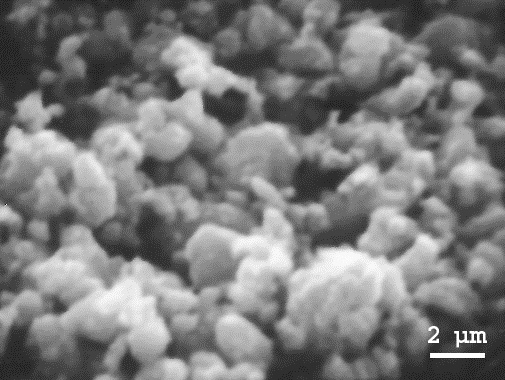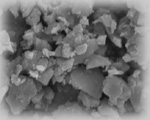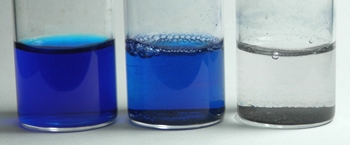Oxycatalyst
Hydrogen Link developed innovative families of proprietary catalysts, which have shown outstanding catalytic performance in various types of reactions. One group, namely the OXYCATALYSTS, specifically targets catalysis involving oxidation reactions.

These complex catalytic materials have a proprietary coordination arrangement, which emphasizes a novel concept of the complex interatomic interactions between the reactants and the catalyst. The concept allows the targeted design of the specific catalyst composition for particular reactions, underlining the versatility between composition and properties of the resulting nano-catalyst compounds. The key point is that the outstanding catalytic properties can be obtained only when a specific hetero-complex is formed, thus enabling a multitude of reactions and processes through charge transfer.
Oxycatalyst compounds can be applied with exceptional efficiency in a wide range of oxidative reactions, from pollution remediation and organic oxidation to functional groups oxidation and Catalytic Advanced Oxidation.
Catalytic Advanced Oxidation (catalytic decomposition of hydrogen peroxide H2O2 with the oxycatalyst) is one of the most powerful oxidative reactions, as the result generation of incomparable quantity of hydroxyl radicals. Hydrogen peroxide can be also decomposed by other, conventional catalysts (such as manganese oxide, silver, platinum etc.), but the decomposition mechanism mostly involves direct formation of oxygen gas, with only very limited number of hydroxyl radicals. Our unique catalyst is based on nano-technology involving selective formation of varied oxidation states in the catalyst components and therefore is capable of abundant generation of hydroxyl radicals while decomposing hydrogen peroxide. This exceptional feature gives this method an outstanding oxidative capability.
Catalysis is one of the most important fields of chemical technology, which determines the viability of many essential chemical processes. The most efficient catalysts require however either a high content of noble elements (for example platinum or palladium which are expensive) or elaborated production processes involving complex steps to increase the catalysts surface area and to introduce a suitable support). This is usually followed by “activation” i.e. some special treatment such as high-temperature annealing in vacuum or hydrogen. Moreover, most catalysts often become rapidly deactivated when exposed to air. They need to be therefore handled under protective atmosphere, and pre-treated at high temperatures after exposures to air in order to regain their catalytic properties.

By contrast, the most striking practical property of the new catalysts is that they do not deteriorate upon exposure to air or moisture, or after prolonged storage. After fabrication, the new catalysts are already in their final, active state, with no need for further activation, calcination, high temperature annealing, or any kind of preparation/reduction process. The catalysts can be stored indefinitely without any loss of their activity and structure, even without protective atmosphere.
Another advantage is that the oxycatalyst is heterogeneous (i.e. it is in the solid state) and it does not have to be dissolved to form soluble salts in the Advanced Oxidation solution. It remains in the solid state and can be therefore re-used in the subsequent processes, without any need for re-activation.

Moreover, the performance of the Catalytic Advanced Oxidation is optimum at neutral pH, without any need to introduce high acidity (as is required for the Fenton reactions) while it still exhibits extraordinary capability in hydrogen peroxide decomposition in both alkaline and acidic conditions. In these characteristics it is indeed superior to Fenton reactions, which require pH adjustments. Oxycatalyst has been shown to be stable and controllable, with unlimited shelf life.
We have developed a wide range of the catalyst sizes - from a very fine powder to granules up to 5 mm and even larger. The powder has a relatively faster kinetics because of the larger surface area. The granulate is however more convenient to handle and to reuse.
around 5 mm size
Our extended study of a selection of the oxycatalysts (which in practice represent many possible combinations of specific molecular arrangements) showed indeed the enormous potential of this type of catalytic complexes for many chemical reactions.The greatest prospect for the new catalysts lies in the possibility to directly design a specific composition of the catalyst in order to achieve the most efficient performance in the particular chemical reaction. This is ensured by the flexibility of the manufacturing process, which allows us to introduce almost any desired element or alloy into the complex arrangement.
The critical feature of the Oxycatalyst - i.e. the ability to generate one of the most powerful oxidative species – hydroxyl radicals can be directly evidenced and measured in a simple test with Methylene Blue solution. Methylene Blue (methylthioninium chloride) is a sensitive indicator of the presence of hydroxyl radicals, because it can undergo decoloration in the oxidative environment only through the interaction with hydroxyl radicals. Otherwise, the decoloration of Methylene Blue is observed only in reduction reactions.
Illustration of such test is shown below. The solution of Methylene Blue (vial on the left side) was treated with hydrogen peroxide catalyzed by two different catalysts: manganese dioxide (MnO2) - middle vial -and the Oxycatalyst - right vial. The amounts of the hydrogen peroxide and the catalysts were identical in both cases. The reaction in the vial with the Oxycatalyst was much faster and finished within minutes. The reaction in the vial with manganese dioxide was much more sluggish.
The picture below was taken after the signs of hydrogen peroxide decomposition ceased completely in both vials, which took minutes for the Oxycatalyst and hours for MnO2. The color in the manganese dioxide vial did not change very much, indicating very limited (if at all) generation of hydroxyl radicals. On the other hand, the methylene blue solution in the right vial with the Oxycatalyst was totally transparent already after several minutes, without any signs of the blue color in the solution. This simple test demonstrates the powerful hydroxyl radicals by the Oxycatalyst.

Please contact us with inquires related to cooperation and purchase of our catalysts: Contact for Inquiry or contact@hydrogenlink.com
Read more:
- Overview
- Catalytic Advanced Oxidation
- Hydroxyl Radicals Reactivity
- Organic Matter Degradation with Catalytic Advanced Oxidation
- Wastewater treatment with Catalytic Advanced Oxidation
- Dye Decoloration and Degradation with Catalytic Advanced Oxidation
- Catalytic Oxygen Generation
- Cellulose Fibers Upgrading with Catalytic Advanced Oxidation
